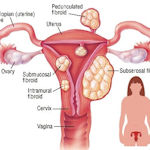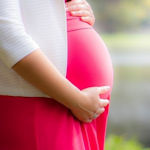
Dr. Maxwell Nartey
Professor of Symptometric Science, American School of Symptometry, NFP
Definition
A fibroid is a fibrous structure that grows in a fault line within the endometrium, or outside the uterus, but still within the abdominal cavity. The fibroids that grow outside the uterus (subserosal fibroids) have a stalk that attaches them to the uterine wall.
There are three kinds of fibroids that grow inside the uterus. These are the intramural fibroids, the submucosal fibroids and some pedunculated fibroids.
The intramural fibroids grow inside the walls of the uterus. The submucosal fibroids grow under the mucus lining of the endometrium. The intramural fibroids and the submucosal fibroids do not have a stalk. They receive oxygen, water and nutrients directly from the capillaries that nourish the endometrium, the perimetrium, and the myometrium.
All the pedunculated fibroids have a stalk, and in this stalk are capillaries. It is these capillaries that supply the oxygen and the nutrients that make the fibroids grow in the uterus or outside the uterus.
Fibroid comes from the word, “Fiber”, meaning it is the collagen fibers that produce these fibroids. In woman’s abdominal cavity are two different kinds of collagen fibers: 1) the collagen fibers that produce fibroids and 2) the collagen fibers that do not produce fibroids.
What causes fibroids?
The collagen fibers that produce fibroids are extremely malnourished; and such malnourished fibers are always found in a fault line. What blocks their nourishment? It is fat globules from saturated fat that block their nourishment.
In the human body, a group of cells that are deprived of water, oxygen and nutrients, will find an alternate source of nourishment. Usually, this alternate source of nourishment is negative energy.
Therefore, it is negative energy that grows the fibroid. The more negative energy a woman has, the faster her fibroids will multiply and grow.
The women who are not likely to have fibroids meet the following criteria: 1) they produce enzymes to completely digest daidzein and genistein in soy products 2) they produce two different lipases, lipotropic hormone and liver emulsification enzymes to thoroughly digest the sources of saturated fat like eggs, butter, nuts, etc., and 3) they experience minimal emotional stress.
Basically, it is “minimal emotional stress” that determines whether a woman will become susceptible to fibroids or not. Why is overwhelming emotional stress, which derives from negative energy, the determining factor in having fibroids?
Negative energy consists of pent-up negative emotions. Examples of negative emotions include: anger, irritability, frustration, refusal to forgive, death of a loved one, separation, divorce, severe depression, disappointments, grief, sufferings, hurt, traumas, abuse, loss of privacy or dignity, etc..
It is women between ages 18 and 40, who do not share their concerns or negative emotions with anyone, who tend to experience a lot of emotional stress.
It is excessive emotional stress from pent-up negative emotions coupled with fat residues, and sometimes, unmetabolized daidzein and genistein from soy, that make fibroids grow. Hence, the connection between diet/lifestyle and fibroids; and the connection between negative emotions and fibroids.
For example, a fibroid that measured only 2 cm across in the year 2000, measured 10 cm in 2012, twelve years later. What happened in 12 years? What happened was, the growth of the woman’s fibroid was fueled by excessive emotional stress. During those twelve years, she endured grief from the death of her beloved mother, divorce, custody battle, loss of her job and income, loss of her home, relocation stress, etc.
There have been speculations about fibroids being a disease of Black women, a disease of corn eaters, etc., none of which is true because these accounts could not be scientifically verified. Fibroids do occur in non-Black women who eat soy, saturated fat, do not produce enzymes and are under a lot of emotional stress.
Why is pent-up negative emotions such a major factor in the development and rapid growth of fibroids? Here is the explanation.
We are energy
What are we? We are matter, and matter is energy. In water, food and in our cells are positive energy and negative energy.
Positive energy has never caused a disease in anyone. It is always the abundance of negative energy in the form of anger, irritability, reserved attitude, non-communicative attitude, tendency to not share personal concerns with anyone, etc. that turn the abdominal cavity into a vortex of negative energy.
The pressure of negative energy on the serous membrane, the mucus membrane, the endometrium, etc. would be so much that a fissure will occur.
This fissure would be a fault line that will give rise to a small fibroid, or many small fibroids on the uterine floor.
A woman can fight back, and not countenance nonsense from anyone, etc., which is good because this is the kind of personality we need in this world. Unfortunately, the question is, does she produce enough enzymes to thoroughly digest saturated fat, and soy products? If she does not, she will increase her chances of having fibroids.
Fibroids have always been emotional anomalies and enzymatic disorders. Symptometry classified them as such after completing its research on positive and negative energies, botany and food science.
Location of the fibroid
To a doctor of Symptometry, the fibroid’s location is irrelevant. A fibroid is a fibroid, and all fibroids begin in the same manner, and their growth is fueled by soy and negative energy.
However, to a surgeon, the location of the fibroid is significant because it helps to determine the surgical strategy and the procedure that should be used.
For example, the location would enable the surgeon to decide if there should be one abdominal incision, two incisions, or three incisions? Should the fibroid be burned with laser? If it is too difficult to take out the fibroids because they are intramural or submucosal, should partial hysterectomy or total hysterectomy be the final outcome? These are the questions that may keep the surgeon up for most of the night.
The surgeon
Choosing a surgeon to remove the fibroid or fibroids, is extremely important. This is because not all surgeons are good.
So far, the best surgeons for fibroid removal have been females. These females were first gynecologists before they became surgeons, and they specialized in myomectomy.
A female surgeon with such a background and experience would be extremely hesitant to consider partial hysterectomy or total hysterectomy as one of her options.
Her objective will always be to save the woman’s reproductive organs during the surgical procedure. If he or she claims that the woman’s reproductive organs cannot be saved, this should be a cause for concern. The reproductive organs mean a lot to a woman. This is why their removal may cause additional emotional trauma.
Also, it is important to emphasize that the surgeon can remove the fibroid, but another fibroid will grow to replace the fibroid that was removed. This is why it is important to get a doctor of Symptometry involved in fibroid prevention after the surgical removal of the fibroid or fibroids.
The fact of the matter is, a surgeon has no knowledge of root-cause therapeutics, and did not study food science and energy. The doctor of Symptometry did, and this is the difference.
Structure of a fibroid
The physical examination of a fibroid after it has been surgically removed, reveals the fibroid as a mass of fibrous tissue. Negative energy makes it grow bigger until it becomes a reservoir for undesirables. It will store unwanted blood, fat globules, casts and saturated fat. Saturated fat will harden the fibroid and turn it into a heavy solid mass.
There have been instances where the fibroid grew so big that it prevented the fetus from growing to its normal size. As a result, the baby was born underweight. There have also been instances where the baby grew so big that its weight put so much pressure on the fibroid that it burst, causing severe vaginal hemorrhaging during delivery. Read more about fibroids in part 2 of this series.
© Copyright 2021, The American School of Symptometry, NFP. No part of this publication may be reproduced or transmitted in any form or by any means, electronic or mechanical, including photocopying, recording, or by any information storage and retrieval system without the written permission of The American School of Symptometry, NFP. Library of Congress copyright number Txu 1-621-370, Washington D.C.


 Next Post
Next Post